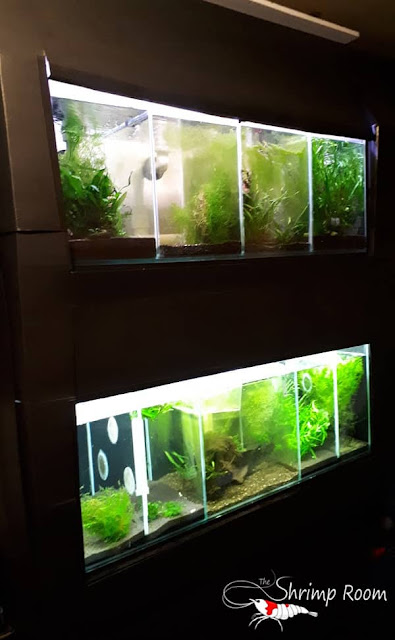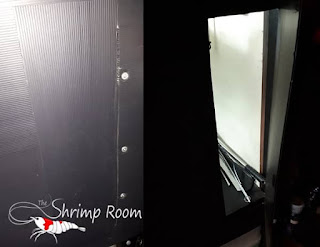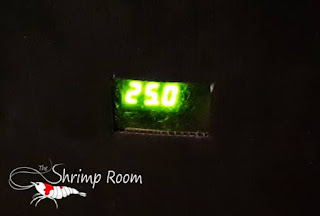How to insulate a fish tank rack for less than $50.
During
winter, I usually allow the temperature to slowly drop to around 20
degrees. One reason is to reduce my power bill as it is already high
enough and also as the rate of breeding and gestation periods is
influenced by the temperature, lowering the temperature will give the shrimp a rest from constant breeding and in my opinion seems to increase their lifespan.
With winter night time temperatures dropping into the mid single digits, I was noticing that the heater was on all the time and struggling to keep the rack up above 20 degrees. Either I would have to add another heater which would increase my power bill or I needed to do something about the night time temperature loss.
I decided to insulate the whole rack with cor flute (fluted polypropylene) which is often used as a floor protection during home renovations or building and can be purchased from most building material suppliers.
I found Bunnings was selling 2400x1200 sheets for around $10 each so after a quick trip to Bunnings and a few awkward looks as I was squeezing the large sheets of cor flute into a tiny Toyota Echo I was home with three sheets and a five metre roll of Velcro.
With winter night time temperatures dropping into the mid single digits, I was noticing that the heater was on all the time and struggling to keep the rack up above 20 degrees. Either I would have to add another heater which would increase my power bill or I needed to do something about the night time temperature loss.
I decided to insulate the whole rack with cor flute (fluted polypropylene) which is often used as a floor protection during home renovations or building and can be purchased from most building material suppliers.
I found Bunnings was selling 2400x1200 sheets for around $10 each so after a quick trip to Bunnings and a few awkward looks as I was squeezing the large sheets of cor flute into a tiny Toyota Echo I was home with three sheets and a five metre roll of Velcro.
The
sheets needed to be cut or folded to fit them into the car so I
measured it all up so nothing was wider than seventy centimetres which
just fit whilst leaving me enough room to drive. Thankfully it is easy to cut straight lines along the sheets as the knife will follow the channels.
Folding two of the sheets meant that I could use full sheets for the front and with the third sheet, cut in half, I then had half for the left side and half to surround the sump and chiller. The right side only needed a small piece as the plywood panel to attach the power covers between the shelves on the right end.
Using the Velcro tape I was easily able to attach all of the panels and it means that if I want to remove it or make any changes it's as easy as running your hand through to break the bond. Initially I only used small sections of Velcro spaced along the edges to hold it all together, unfortunately over time this sagged in some areas due to the side stuck to the rack coming unstuck.
Folding two of the sheets meant that I could use full sheets for the front and with the third sheet, cut in half, I then had half for the left side and half to surround the sump and chiller. The right side only needed a small piece as the plywood panel to attach the power covers between the shelves on the right end.
Using the Velcro tape I was easily able to attach all of the panels and it means that if I want to remove it or make any changes it's as easy as running your hand through to break the bond. Initially I only used small sections of Velcro spaced along the edges to hold it all together, unfortunately over time this sagged in some areas due to the side stuck to the rack coming unstuck.
I made some hatches to allow access to the tanks for feeding and maintenance
by cutting through the inside layer of the cor flute along one of the
channels where the fold would be and then cutting up to this line. To
increase the stiffness of the hatch I folded the bottom edge into a
triangle, holding it in place with black cloth tape and then using a
small tab of Velcro to hold it shut.
As
the sump needs to be accessed occasionally I made it so the front panel
is separate and can be easily removed. This allows full access around
the sump to be easily able to make any modifications.
The
access panel for the tool storage space needed to have a vertical hinge
which was perpendicular to the channels. I cut out the area I wanted to
access and used an off cut with the channels running vertically to make
the hinge easily. This was fixed into place using rivets as it was the
simplest and strongest method available to me.
Insulating the chiller is only for winter as it needs airflow for the cooling to work, however the large cooling fins which help dissipate the heat when the chiller is running also conversely affect the heating ability so this needed to be covered. I also cut a small window and taped some clear plastic over the hole so I can see the temperature of the chiller at a glance.
Benefits of insulating an aquarium.
By insulating the whole rack, it holds in the heat from the lights and helps prevent cold air from flowing around the tanks.After installing all of the cor flute, the heater went from being on all the time and the temperature dropping to under 18 degrees overnight, to stable at 20 degrees and not being required to run constantly. For the cost of the cor flute it would have to turn the heater off for 300 hours to break even which should be easily achieved over winter.







Comments
Post a Comment